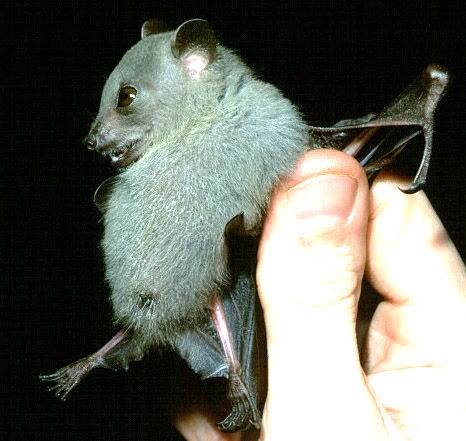| Citation |
Csorba, G., Bumrungsri, S., Francis, C., Bates, P., Gumal, M., Kingston, T., Molur, S. & Srinivasulu, C. 2008. Cynopterus brachyotis. The IUCN Red List of Threatened Species 2008: e.T6103A12432460. http://dx.doi.org/10.2305/IUCN.UK.2008.RLTS.T6103A12432460.en. Downloaded on 29 May 2019. |
Description |
Geographic Range [top]
Range Description: This widespread species ranges from South Asia, through parts of southern China to parts of Southeast Asia. In South Asia, this species is presently known from Bangladesh (Sylhet division) (Sarker and Sarker 2005; Srinivasulu and Srinivasulu 2005), India (Andaman and Nicobar Islands, Gujarat, Karnataka, Kerala, Madhya Pradesh, Maharashtra, Meghalaya, Orissa, Uttar Pradesh and West Bengal) and Sri Lanka (North Central, Uva and Western provinces) (Srinivasulu et al. in press; Molur et al. 2002). In southern China, it has been recorded from Guangdong, with possible records from Xizang (Medog) and southern Yunnan (Wang 2002; Smith and Xie 2008). In continental Southeast Asia, it is known from southern Myanmar, Thailand, Lao PDR, Viet Nam (identity of records from northern Viet Nam need verification), Cambodia (known only from Phnom Phen [G. Csorba pers. comm.]), and Peninsular Malaysia. In Insular Southeast Asia, it is known from the islands of Sumatra and Java (Indonesia), Borneo (Indonesia and Malaysia only), the island of Sulawesi (Indonesia), the island of Timor (East Timor and Indonesia), the Talaud Islands (Indonesia) and Ternate Island (Indonesia). It might be present on the island of Palawan in the Philippines, but this requires confirmation.
Countries occurrence:
Native:
Cambodia; China; India (Andhra Pradesh, Bihar, Goa, Karnataka, Maharashtra, Nagaland, Tamil Nadu); Indonesia (Sulawesi, Sumatera); Lao Peoples Democratic Republic; Malaysia; Myanmar; Singapore; Sri Lanka; Thailand; Timor-Leste; Viet Nam
Additional data:
? Estimated area of occupancy (AOO) - km2: >2,000
? Upper elevation limit (metres): 1600
Range Map: Click here to open the map viewer and explore range.
Population [top]
Population: In northeast India, the population is stable and it is common but not as abundant as Cynopterus sphinx (Tarapada Bhattacharyya pers. comm. June 2005), while in southern India it is rare (C. Srinvasulu pers. comm. September, 2007). In Southeast Asia, it is generally locally abundant and most common in disturbed and residential areas, however, is locally rare in Peninsular Malaysia and Thailand (Campbell et al. 2004).
Current Population Trend: Unknown
Additional data:
? Population severely fragmented: No
Habitat and Ecology [top]
Habitat and Ecology: This species can be found from habitats ranging from orchards, gardens to forested tracts. It roosts in palms especially seed clusters of palms either solitary or in small groups of a few individuals in rural and urban landscapes and in forested areas. Bears a single young after a gestation period of 105-120 days (Bates and Harrison 1997). In South Asia, the species is believed to be more restricted to higher elevations when compared to C. sphinx, making it specifically a hill forest species.
Systems: Terrestrial
Threats [top]
Major Threat(s): There are no major threats to this species as a whole. In South Asia, this species is locally threatened by deforestation, generally resulting from logging operations and the conversion of land to agricultural and other uses (Molur et al. 2002).
Conservation Actions [top]
Conservation Actions: Other than further taxonomic studies, no conservation actions are currently needed for the species as a whole. It is present in many protected areas throughout its range. In South Asia, this species like most other fruit bats in India is considered a vermin under Schedule V of the Indian Wildlife (Protection) Act. The species has been recorded from protected areas in India like Nagarhole National Park in Karnataka and Kalakkad-Mundunthurai Tiger Reserve in Tamil Nadu, and in Hakgalla National Park in Sri Lanka.
Citation: Csorba, G., Bumrungsri, S., Francis, C., Bates, P., Gumal, M., Kingston, T., Molur, S. & Srinivasulu, C. 2008. Cynopterus brachyotis. The IUCN Red List of Threatened Species 2008: e.T6103A12432460. http://dx.doi.org/10.2305/IUCN.UK.2008.RLTS.T6103A12432460.en. Downloaded on 05 April 2017.
Disclaimer: To make use of this information, please check the .
Feedback: If you see any errors or have any questions or suggestions on what is shown on this page, please provide us with feedback so that we can correct or extend the information provided
|

